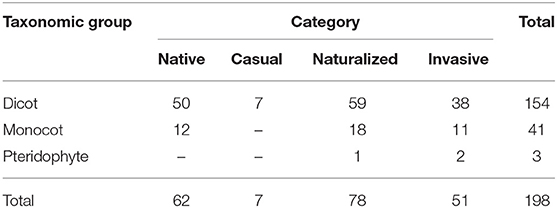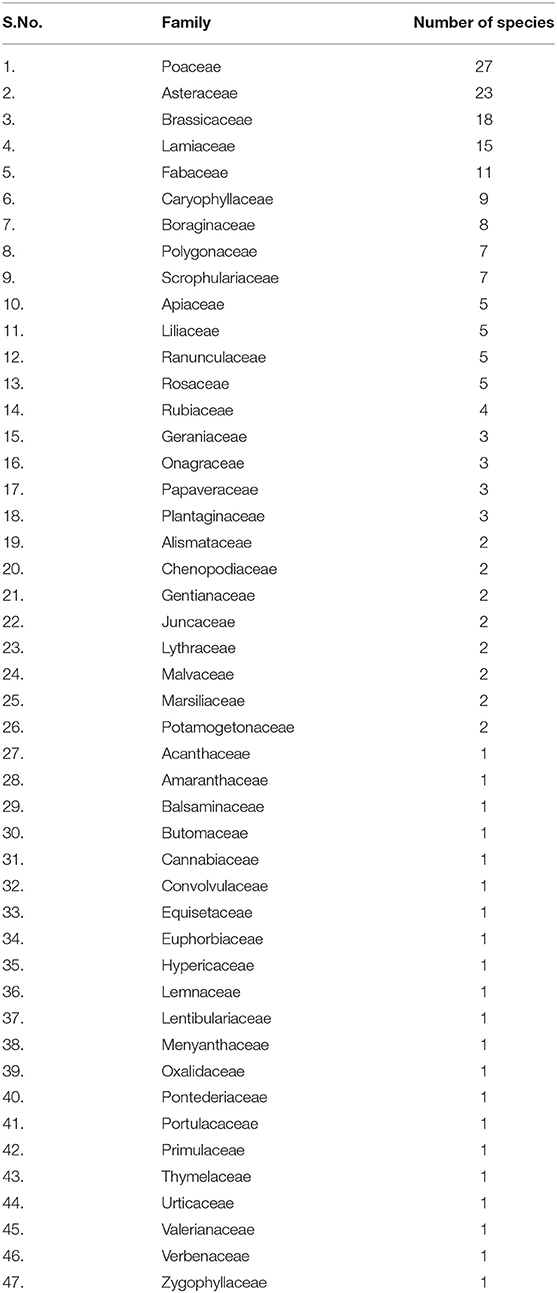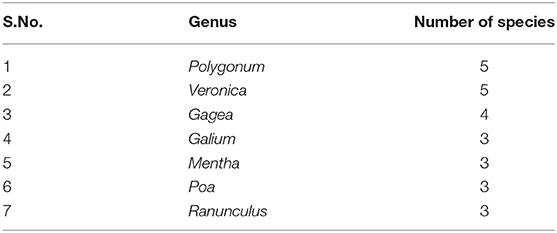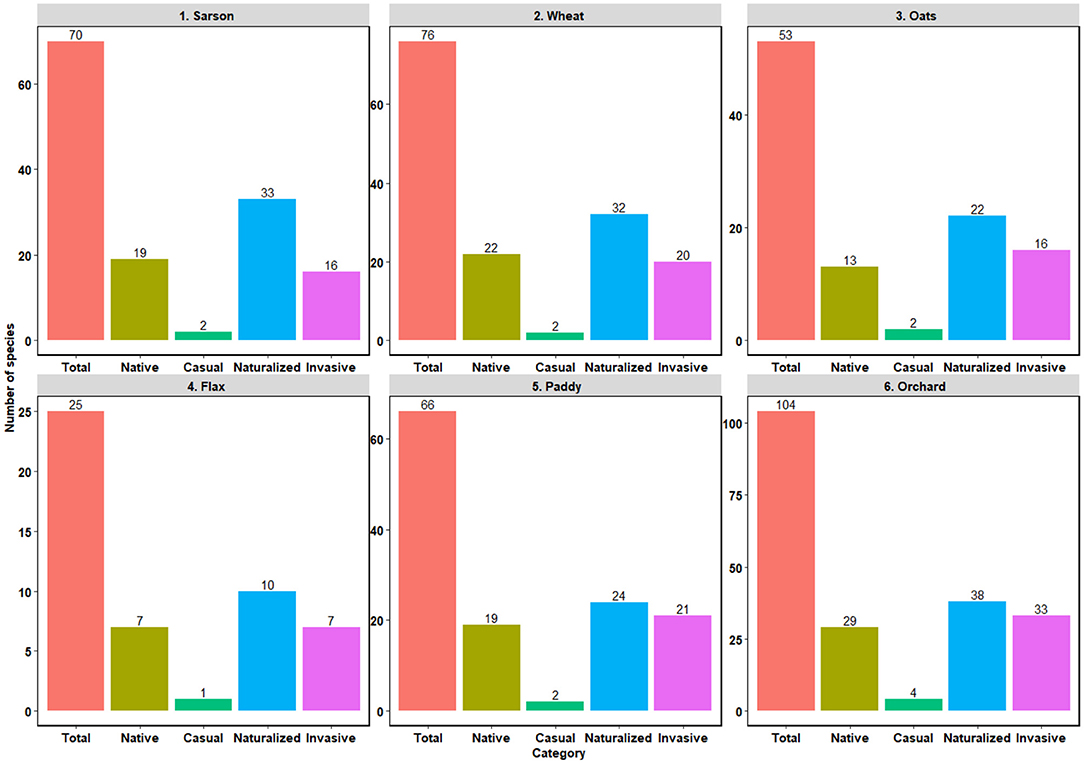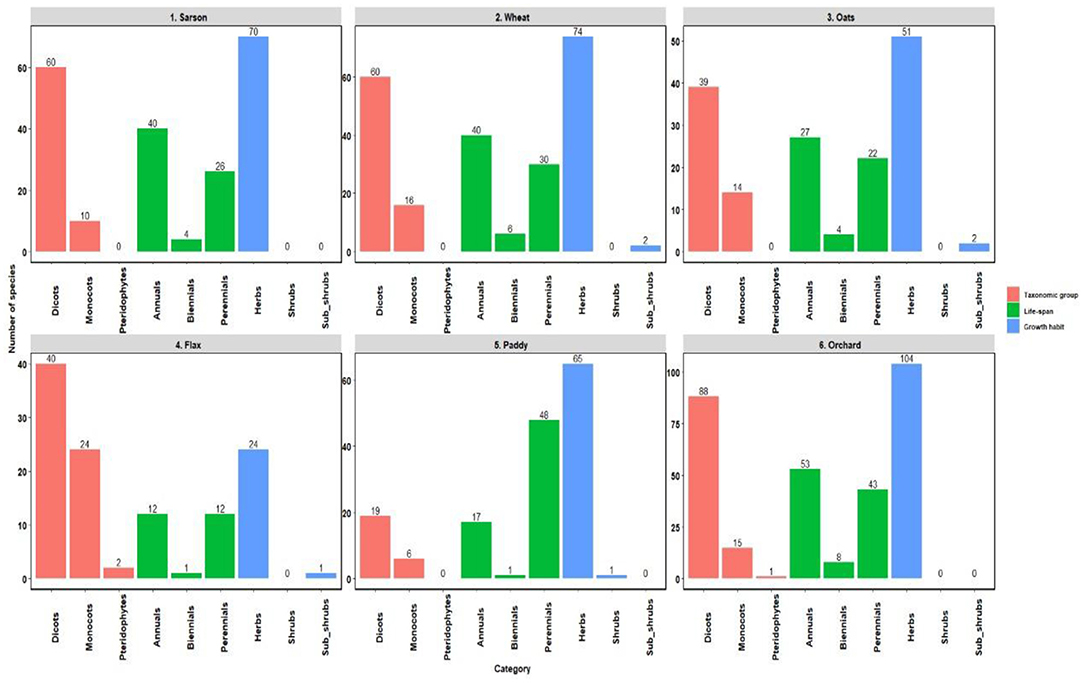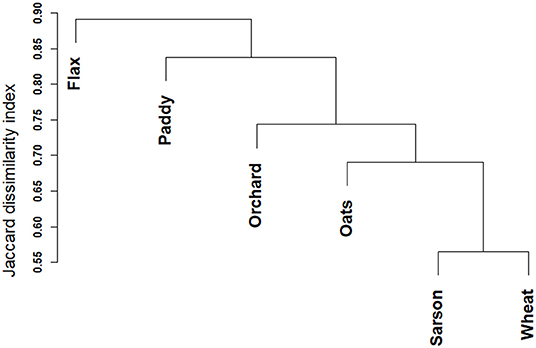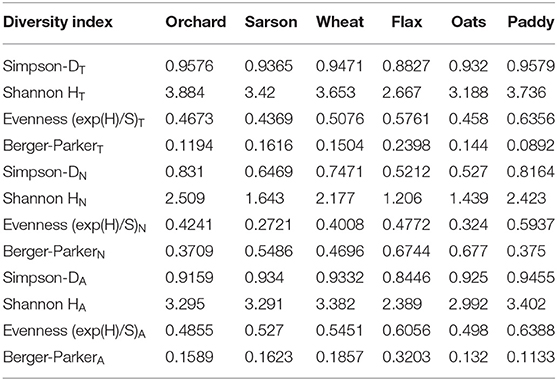- 1Department of Botany, Amar Singh College, Cluster University Srinagar, Srinagar, India
- 2Department of Botany, University of Kashmir, Srinagar, India
Weeds, unwanted plants, are responsible for significant yield and economic loss in agroecosystems and pose a serious threat to the ecology and efficiency of these ecosystems. Despite these losses, not much is known about the weeds associated with crops grown in Kashmir Himalaya. Here, we present a complete inventory of weeds associated with rabi crops, such as mustard (Brassica campestris), wheat (Triticum aestivum), flax (Linum usitatissimum), oats (Avena sativa), kharif crop, such as paddy (Oryza sativa), as well as apple and other fruit tree orchards. A total of 198 weeds were recorded belonging to 47 families. Poaceae (27 species) and Asteraceae (23 species) included the highest number of species. Most of these weeds were non-native (136 species) and only 62 species were native. Fifty one non-native species were invasive. Most of the weeds were herbs (195 species). Annuals and perennials were almost equally represented with 93 and 92 species, respectively. The number of weeds varied across the surveyed crops with the highest number of species (104) recorded in orchards and the lowest number of 25 species in flax fields. These observations are important for the better management of weeds in the agroecosystems of Kashmir Himalaya.
Introduction
Invasive alien species (IAS) are known to have profound ecological (Bartz and Kowarik, 2019) and economic impacts (Diagne et al., 2021). Currently, the total costs of biological invasions worldwide were estimated at a minimum of US$1.288 trillion between 1970 and 2017 with an annual mean cost of US$26.8 billion (Diagne et al., 2021). In India, the cost of invasive alien species to the economy has been estimated at US$ 127.3 billion to 182.6 billion (Indian Rupees ₹ 8.3 trillion to 11.9 trillion) over 1960–2020 (Bang et al., 2021).
Agroecosystems are particularly vulnerable to invasion by alien species because of high anthropogenic disturbance, high nutrient availability and poor phytosanitary measures etc. (Jiang et al., 2017). Consequently alien invasive species are now recognized as a major threat to global agriculture and food security (Paini et al., 2016). Historically, agriculture has been intimately linked to biological invasions (Guillemaud et al., 2011) as the advancement of agriculture allowed the worldwide spread of human populations which in turn facilitated invasion through intentional and/or unintentional introduction of alien species (Mack et al., 2000). These alien species tend to be better competitors (D'Antonio and Kark, 2002; Daehler, 2003; Rout and Callaway, 2009; Matzek, 2012) and generalists, and their establishment is often favored by the addition of nutrients to agricultural fields to improve crop yields (Cox et al., 2014; Allen et al., 2016). Once established, they interfere with the crops through competition for resources, production of toxins that inhibit the growth of other plants (allelopathy), contamination of harvested crops, the spread of diseases by acting as secondary hosts for crop pests, direct interference with harvesting and requirement for additional cleaning and processing (Fried et al., 2017; Bajwa et al., 2019). Research has revealed that weeds are responsible for 34% of agricultural losses (Radicetti and Mancinelli, 2021) with the magnitude of impact varying between countries or locations (Lovell et al., 2006; Paini et al., 2016) as 10% yield loss has been attributed to weeds in less developed countries and 25% in the least developed countries (Akobundu, 1987).
India, with the highest net cropland area of 179.8 Mha (9.6 per cent of the global net cropland area) in the world, is critically dependent on agriculture as this sector contributes about 16 per cent to the country's economy and accounts for about 49 per cent of employment [GOI (Government of India), 2018]. Despite progress made in producing adequate quantities of food grains, India still faces a complex challenge of food and nutritional security as about 15 per cent of the Indian population is reported to be undernourished (FAO, 2018). This number may increase substantially with an increase in the human population in India, which is projected to reach 1.7 billion by 2050. Thus, the development of strategies and technologies that specifically address the agriculture production constraints, such as weeds need to be urgently considered as weeds compete with crops for all the inputs and the economic loss, due to weeds in 10 major crops of India, was estimated at US$ 11 billion (Gharde et al., 2018). Hence managing weeds is critical to higher agricultural productivity, improved resources use efficiency, meeting the food and nutritional requirements of the ever-increasing human population and also increasing the income of farmers (Rao and Chauhan, 2015).
In two Union Territories of India (Jammu & Kashmir and Ladakh) as well, agriculture is the major economic activity and about 70% of the human population earn their livelihood directly or indirectly from the agriculture and allied sectors (Hassan et al., 2015; Wani and Mir, 2019). In Kashmir, paddy is the main crop, followed by maize, oilseeds, pulses, vegetables, fodder and wheat. In the Jammu region, wheat is the major crop followed by maize, paddy, pulses, oilseeds, fodder, vegetables and other crops while in Ladakh, barley is the major cereal crop followed by wheat. Of late, horticulture is evolving into a dominant economic activity in the region with apple, apricot, pear, and plum orchards being established at an increased rate. The horticulture sector is also a major contributor to the regional economy and is a source of livelihood for about 33 lac people and about seven lakh families are directly or indirectly involved and depend on the horticulture sector.
Keeping in view the deleterious impact of invasive alien weeds on agricultural productivity, it is essential to integrate efforts to manage weeds in crops to reduce weed-crop competition for optimal use of resources by crops, such as nutrients, water and sunlight, and optimal harvestable crop yield (Rao and Nagamani, 2007, 2010). While many weed management technologies have been developed to assist farmers (Rao et al., 2014a,b), weeds continue to be a major problem in the agroecosystems (Rao et al., 2018). Continuous effort is also required to monitor the ever-changing weeds in different ecosystems due to continued introduction and establishment of alien species. There is an immediate need to develop pre and post-border weed risk assessment frameworks for better management of invasive alien weeds in the agroecosystems. Against this backdrop, the present study was carried out to document the weeds growing with different crops and their characterization in terms of lifespan, habit and invasion status and identify the weeds that require urgent attention for management.
Materials and Methods
The present study was carried out in Kashmir Himalaya- a place where the major means of earning livelihood for people is agriculture. As per the statistics of the State Agriculture Department (Table 1), main crops cultivated in Kashmir Himalaya include paddy, wheat, maize, pulses and oilseeds with paddy being the most dominant crop in terms of area under cultivation.
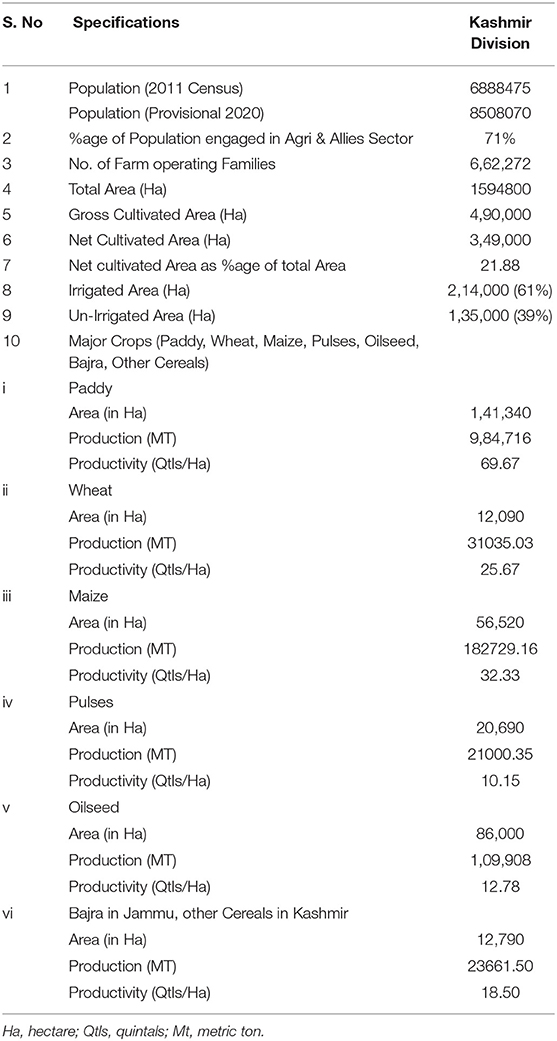
Table 1. Major crops cultivated in Kashmir Himalaya and the percentage of population dependant on agriculture activities (Source: Agriculture Department, J&K).
For this study, both primary, as well as secondary data, were used. Data obtained from surveys carried out by Siddiq et al. (1985), Reshi et al. (1986) and Dar and Reshi (2020) was compared and the analysis was done using software like Past3 and vegan which are available in the R platform (R Core Team; R version 4.1.0). Species presence-absence data was used for making comparisons between surveyed habitats and for calculating Jaccard's dissimilarity index. Abundance data (collected by quadrat method) was used for calculation of species diversity indices. The level of invasion results from both the habitat properties and the propagule pressure (Chytrý et al., 2005, 2008; Hierro et al., 2005; Richardson and Pyšek, 2006). This term is different from habitat invasibility, which is the habitat's susceptibility to invasion imposed by abiotic and biotic constraints under the assumption of constant propagule pressure (Lonsdale, 1999). Various studies have computed this parameter for habitat comparisons. In the present study, the level of invasion was expressed both as the proportion of alien to all plant species per site (now written as the proportion of alien species) and, the proportion of invasive species to all alien plant species per site (now written as the proportion of invasive species). The level of invasion per site was calculated as:
Keeping in view the potential ambiguity of indices that consider rare and common taxa equally (richness) or that weight species relative to their abundances (heterogeneity), six different indices [i.e., Simpson, Shannon, Evenness, Equitability (J), Fisher's alpha and Berger-Parker] describing the species diversity, richness and evenness were used for making comparisons between habitats. These indices were calculated in three different ways, firstly with all the species present (shown by subscript T with name), secondly with only native species (shown by subscript N with name) and thirdly with only alien species (shown by subscript A with name) for each agroecosystem using Past 3.0. This was done to make comparisons of surveyed croplands with and without alien species.
Results
Analysis of data revealed that a total of 198 (Appendix I) weed species were associated with the surveyed agroecosystems, out of which 136 were alien (78 naturalized, 51 invasive and 07 casual species) and only 62 were native (Table 2). Dicots were predominant with 154 species while monocots and pteridophytes were represented by 41 and three species, respectively (Table 2). These species belonged to 47 families and 152 genera. The most representative families were Poaceae (27 spp.), Asteraceae (23 spp.), Brassicaceae (18 spp.), Lamiaceae (15 spp.), Fabaceae (11 spp.), and Caryophyllaceae (09 spp.) (Table 3). The most representative genera were Polygonum (05 spp.), Veronica (05 spp.), and Gagea (04 spp.) (Table 4). Herbs were dominant with 195 spp. and only a very limited number of subshrubs (02 spp.) and shrubs (01 spp) was recorded. Most of these species were annuals (93 spp.) followed by perennials (92 spp.) and 13 were biennial (Table 5).
The surveyed agroecosystems differed in terms of the number of native and alien species (Figure 1). One hundred and four species were present in orchards, out of which only 29 were native and 75 were alien (04 casual, 38 naturalized and 33 invasives) species. In mustard fields, a total of 70 species were recorded, out of which 19 were native and 51 were alien (02 casual, 33 naturalized and 16 invasives) species. In wheat fields, a total of 76 species were recorded; out of which 22 were native and 54 were alien (02 casual, 32 naturalized and 20 invasives) species. In the case of oats, a total of 53 species were recorded; out of which 13 were native and 40 were alien (02 casual, 22 naturalized and 16 invasive) species. In flax cultivated fields, a total of 25 species were recorded; out of which 7 were native and 18 were alien (01 casual, 10 naturalized and 07 invasive) species. In paddy cropland, a total of 66 species were recorded; out of which 19 were native and 47 were alien (02 casual, 24 naturalized and 21 invasive) species. The floristic composition of surveyed agroecosystems also differed with respect to the growth form and life span of inhabiting plant species (Figure 2).
Analysis of data also revealed that all surveyed agroecosystems have been significantly invaded by the alien as characterized by very high levels (>70%) of invasion (Table 6). The level of invasion expressed as the proportion of aliens was highest in oats croplands followed by mustard while the level of invasion expressed as the proportion of invasives was highest in paddy fields followed by orchards.
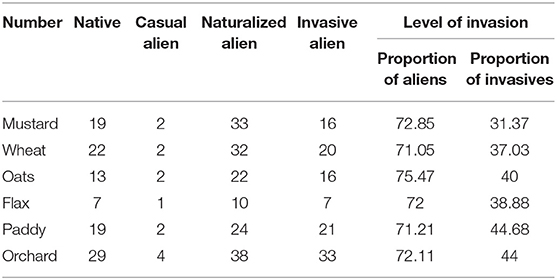
Table 6. Level of invasion expressed as the proportion of aliens and proportion of invasives in different agroecosystems.
The surveyed agroecosystems share a significant number of species most of which are alien thereby indicating the homogenous nature of these habitats. The most similar agroecosystems were mustard (sarson) and wheat cultivated habitats followed by wheat and oats (Figure 3).
The surveyed agroecosytems also differed with respect to species diversity patterns (Table 7). Total species and native species diversity was highest in orchards as this cropland type was characterized by the highest values of Simpson, Shannon, Evenness, and Berger Parker indices. Alien species diversity was highest in other croplands with values of Simpson and Shannon indices being highest in paddy fields. Differences in diversity patterns are due to differences in individual species abundance and frequency as it was observed that abundance and frequency of weed species differs in different agroecosystems (Table 8).
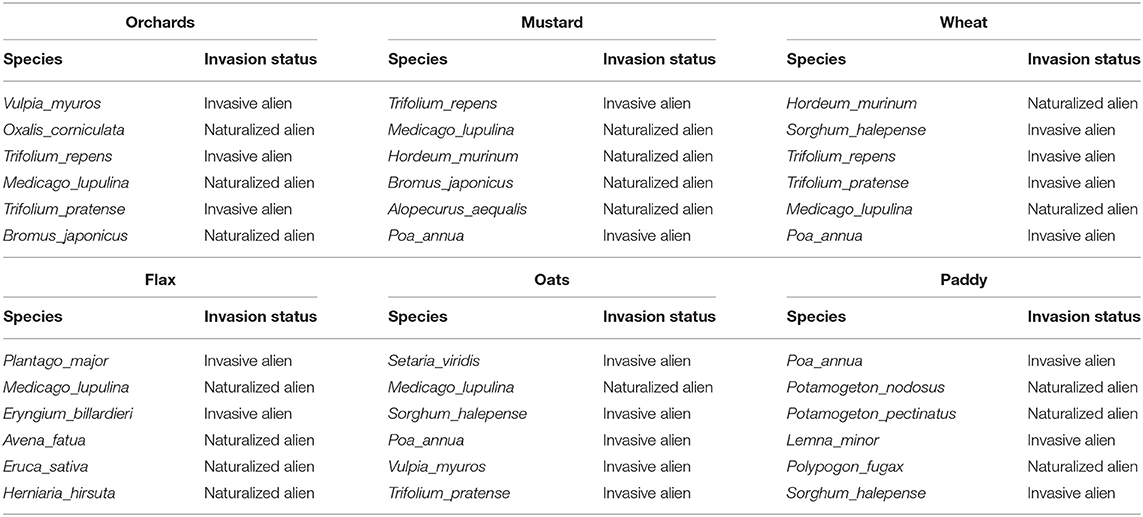
Table 8. Most abundant and frequent (in decreasing order of abundance and frequency) weeds growing in different agroecosystems.
Discussion
Habitat invasibility has been the focus of invasion ecology since its birth and the role of habitats in determining the characteristics of biological invasions has been firmly established (Ruiz et al., 1997; Davis et al., 2000; Inderjit, 2005; Richardson and Pyšek, 2006). But only a few studies provide quantitative data on the representation of alien species in particular habitats across regions (Pyšek and Chytrý, 2013). We quantified both proportion of alien species as well as the proportion of invasive species and the present study reveals that the agroecosystems in the Kashmir Himalaya are dominated by alien weeds with natives representing only 30% of species. In comparison to 29% of alien elements reported by Khuroo et al. (2007) at the state level (Jammu and Kashmir), the present study reports a relatively high proportion (70%) of alien plant species in the agroecosystems. The possible reason for this high percentage of aliens is that Kashmir Himalaya has received intentional or unintentional introduction of alien floral elements from different regions (Khuroo et al., 2007) mainly due to promotion of tourism, import of exotic ornamental and horticultural species for cultivation, etc. The introduction of these alien species has mainly taken place in lowland areas. Representation of floral elements among families is highly uneven with Poaceae, Asteraceae being most dominant. A similar trend was reported by Khuroo et al. (2007) for state flora of the region.
Scientific research in invasion ecology has revealed that habitat characteristics play an important role in determining species diversity (Mitchley and Xofis, 2005; Aggemyr et al., 2018) and subsequent response to biological invasion (Dar and Reshi, 2020). Human mediated changes in eco-physical conditions provide opportunities for species to invade habitats where they were previously not reported (Hobbs et al., 2009; Cameron and Bayne, 2012). Attributes like moderate levels of disturbance and nutrient enrichment in man-managed habitats (in comparison to natural habitats) makes them more susceptible to invasion (Huenneke et al., 1990; Wilson and Tilman, 1993; Duncan et al., 2008) and biotic homogenization.
The results further reveal that partitioning diversity into alien and native components could provide us with a better understanding of species diversity patterns across space. With respect to total and native species richness, evenness and diversity, orchards are more diverse than other croplands. In comparison to other croplands, the orchards are perennial and are generally maintained as intact plots with low degrees of tillage. This gives sufficient time to species for establishment with sufficient levels of disturbance and propagule pressure thereby leading to high diversity (Meiss et al., 2010). On the other hand, paddy fields represent dual habitats with cyclic periods of high water levels and dry soil. Dar and Reshi (2020) reported that among all habitats in Kashmir aquatic habitats are characterized by the highest levels of invasion resulting from low levels of endemicity, low native species richness and physical degradation of aquatic habitats by anthropogenic activities. The Shannon-Weiner, evenness, Simpson and other diversity indices obtained for agroecosystems in the present study are consistent with the values obtained for agricultural ecosystems by Solomou et al. (2013) and Lemage and Legesse (2018).
Management Imperatives
Management of invasive weeds in agricultural ecosystems has evolved as a very difficult challenge for farmers and policymakers. In Kashmir Himalayan region there is no screening protocol in place for checking arrival of alien species. As such there is every likelihood of arrival of propagules of alien species at any time. Also there is no awareness among masses regarding the challenges and perspectives of plant invasion. People mostly rely on classical methods of weed control. In addition there is drastic land use transformation being carried out in the region with people shifting from paddy cultivation to orchards.
This study highlights the role of understanding differences in crop types in management of weeds as specific weeds were found growing with specific crop. As recommended by other researchers in other parts of the world knowledge about ecology of weeds is essential for their management.
Research in agriculture has revealed that invasion by alien species in agroecosystems can be best controlled by measures like crop rotation, balanced fertilization treatment, maintenance of cover crops, intercropping and crop diversification, changing weed regeneration niches and patterns of resource availability, alteration in soil physical, chemical and biological properties.
Data Availability Statement
The original contributions presented in the study are included in the article/Supplementary Material, further inquiries can be directed to the corresponding author/s.
Author Contributions
ZR formulated the hypothesis and helped in writing the manuscript. PD collected and analyzed the data and wrote the manuscript. All authors contributed to the article and approved the submitted version.
Conflict of Interest
The authors declare that the research was conducted in the absence of any commercial or financial relationships that could be construed as a potential conflict of interest.
Publisher's Note
All claims expressed in this article are solely those of the authors and do not necessarily represent those of their affiliated organizations, or those of the publisher, the editors and the reviewers. Any product that may be evaluated in this article, or claim that may be made by its manufacturer, is not guaranteed or endorsed by the publisher.
Supplementary Material
The Supplementary Material for this article can be found online at: https://www.frontiersin.org/articles/10.3389/fagro.2021.788797/full#supplementary-material
References
Aggemyr, E., Auffret, A. G., Jädergård, L., and Cousins, S. A. O. (2018). Species richness and composition differ in response to landscape and biogeography. Landsc. Ecol. 33, 2273–2284. doi: 10.1007/s10980-018-0742-9
Akobundu, I. O. (1987). Weed Science in the Tropics: Principles and Practices. Chichester: John Willey and Sons Ltd. 318–334.
Allen, E. B., Egerton-Warburton, L. M., Hilbig, B. E., and Valliere, J. M. (2016). Interactions of arbuscular mycorrhizal fungi, critical loads of nitrogen deposition, and shifts from native to invasive species in a southern California shrubland. Botany 94, 425–433. doi: 10.1139/cjb-2015-0266
Bajwa, A. A., Farooq, M., Nawaz, A., Yadav, L., Chauhan, B. S., and Adkins, S. (2019). Impact of invasive plant species on the livelihoods of farming households: evidence from Parthenium hysterophorus invasion in rural Punjab, Pakistan Biol. Invasions 21, 3285–3304. doi: 10.1007/s10530-019-02047-0
Bang, A., Cuthbert, R., Haubrock, P., Fernandez, R., Moodley, D., Diagne, C., et al. (2021). Fragmented Yet High Economic Costs of Biological Invasions in India. [preprint]. doi: 10.21203/rs.3.rs-358099/v1
Bartz, R., and Kowarik, I. (2019). Assessing the environmental impacts of invasive alien plants: a review of assessment approaches. NeoBiota 43, 69–99. doi: 10.3897/neobiota.43.30122
Cameron, E. K., and Bayne, E. M. (2012). Invasion by a nonnative ecosystem engineer alters distribution of a native predator. Divers Distrib 18, 1190–1198. doi: 10.1111/j.1472-4642.2012.00912.x
Chytrý, M., Jarosík, V., Pyšek, P., Hájek, O., Knollová, O., Tichy, L., et al. (2008). Separating habitat invasibility by alien plants from the actual level of invasion. Ecology 89, 1541–1553. doi: 10.1890/07-0682.1
Chytrý, M., Pyšek, P., Tichy, L., Knollová, I., and Danihelka, J. (2005). Invasions by alien plants in the Czech Republic: a quantitative assessment across habitats. Preslia 77, 339–354.
Cox, R. D., Preston, K. L., Johnson, R. F., Minnich, R. A., and Allen, E. B. (2014). Influence of landscape-scale variables on vegetation conversion to exotic annual grassland in southern California, USA. Global Ecol. Conserv. 2, 190–203. doi: 10.1016/j.gecco.2014.09.008
Daehler, C. C. (2003). Performance comparisons of co-occurring native and alien invasive plants: implications for conservation and restoration. Annu. Rev. Ecol. Syst. 34, 183–211. doi: 10.1146/annurev.ecolsys.34.011802.132403
D'Antonio, C. M., and Kark, S. (2002). Impacts and extent of biotic invasions in terrestrial ecosystems. Trends Ecol. Evol. 17, 202–204. doi: 10.1016/S0169-5347(02)02454-0
Dar, P. A., and Reshi, Z. A. (2020). Impact of alien species on species composition, floristic and functional diversity of aquatic and terrestrial ecosystems. Trop. Ecol. 61, 446–459. doi: 10.1007/s42965-020-00102-9
Davis, M. A., Grime, J. P., and Thompson, K. (2000). Fluctuating resources in plant communities: a general theory of invasibility. J. Ecol. 88, 528–534. doi: 10.1046/j.1365-2745.2000.00473.x
Diagne, C., Turbelin, A. J., Moodley, D., Novoa, A., Leroy, B., Angulo, E., et al. (2021). The economic costs of biological invasions in Africa: a growing but neglected threat? NeoBiota 67, 11–51. doi: 10.3897/neobiota.67.59132
Duncan, D. H., Dorrough, J., White, M., and Moxham, C. (2008). Blowing in the wind? Nutrient enrichment of remnant woodlands in an agricultural landscape. Landsc. Ecol. 23, 107–119. doi: 10.1007/s10980-007-9160-0
Fried, G., Chauvel, B., Reynaud, P., and Sache, I. (2017). “Decreases in crop production by non-native weeds, pests, and pathogens,” in Impact of biological invasions on ecosystem services (Berlin: Springer), 83–101. doi: 10.1007/978-3-319-45121-3_6
Gharde, Y., Singh, P. K., Dubey, R. P., and Gupta, P. K. (2018). Assessment of yield and economic losses in agriculture due to weeds in India. Crop Prot. 107, 12–18. doi: 10.1016/j.cropro.2018.01.007
GOI (Government of India). (2018). Economic Survey 2017-2018. Chapter 6. Climate, Climate Change, and Agriculture. Rome: Government of India, Ministry of Finance, Department of Economic Affairs, Economic Division. Food and Agriculture Organization (FAO).
Guillemaud, T., Ciosi, M., Lombaert, E., and Estoup, A. (2011). Biological invasions in agricultural settings: Insights from evolutionary biology and population genetics. Comptes Rendus Biologies 334, 237–246. doi: 10.1016/j.crvi.2010.12.008
Hassan, S., Kanhaiya, A., and Munasir, H. (2015). Agriculture Industry linkages in the economy of Jammu and Kashmir India. J. Dev. Agric. Econ. 7, 174–181. doi: 10.5897/JDAE2014.0614
Hierro, J. L., Maron, J. L., and Callaway, R. M. (2005). A biogeographical approach to plant invasions: the importance of studying exotics in their introduced and native range. J. Ecol. 93, 5–15. doi: 10.1111/j.0022-0477.2004.00953.x
Hobbs, R. J., Higgs, E., and Harris, J. A. (2009). Novel ecosystems: implications for conservation and restoration. Trends Ecol. Evol. 24, 599–605. doi: 10.1016/j.tree.2009.05.012
Huenneke, L. F., Hamburg, S. P., Koide, R., Mooney, H. A., and Vitousek, P. M. (1990). Effects of soil resources on plant invasion and community structure in Californian serpentine grassland. Ecology 71, 478–491. doi: 10.2307/1940302
Inderjit (2005). Plant invasions: habitat invasibility and dominance of invasive plant species. Plant Soil 277, 1–5. doi: 10.1007/s11104-004-6638-2
Jiang, M., Huang, Y., and Wan, F. (2017). “Biological Invasions in Agricultural Ecosystems in China,” in Biological Invasions and Its Management in China, Invading Nature - Springer Series in Invasion Ecology, eds F. Wan, M. Jiang, and A. Zhan (Basingstoke: Springer Nature), 11. doi: 10.1007/978-94-024-0948-2_2
Khuroo, A. A., Rashid, I., Reshi, Z., Dar, G. H., and Wafai, B. A. (2007). The alien flora of Kashmir Himalaya. Biol. Invasions 9, 269–292. doi: 10.1007/s10530-006-9032-6
Lemage, B., and Legesse, A. (2018). Management and Socioeconomic Determinants of Woody Species Diversity in Parkland Agroforestry in Tembaro District, Southern Ethiopia. Biodiversity Int. J. 2, 456–462. doi: 10.15406/bij.2018.02.00100
Lonsdale, M. (1999). Global patterns of plant invasions and the concept of invasibility. Ecology 80, 1522–1536. doi: 10.1890/0012-9658(1999)080[1522:GPOPIA]2.0.CO;2
Lovell, S. J., Stone, S. F., and Fernandez, L. (2006). The economic impacts of aquatic invasive species: a review of the literature. Agric. Resourc. Econ. Rev. 35, 195–208. doi: 10.1017/S1068280500010157
Mack, R. N., Simberloff, D., Lonsdale, W. M., Evans, H., Clout, M., and Bazzaz, F. A. (2000). Biotic invasions: causes, epidemiology, global consequences, and control. Ecol. Appl. 10, 689–710. doi: 10.1890/1051-0761(2000)010[0689:BICEGC]2.0.CO;2
Matzek, V. (2012). Trait values, not trait plasticity, best explain invasive species' performance in a changing environment. PLoS ONE 7:e48821. doi: 10.1371/journal.pone.0048821
Meiss, H., Médiéne, S., Waldhardt, R., Caneill, J., and Munier-Jolain, N. (2010). Contrasting weed species composition in perennial alfalfas and six annual crops: implications for integrated weed management. Agron. Sustain. Dev. 30, 657–666. doi: 10.1051/agro/2009043
Mitchley, J., and Xofis, P. (2005). Landscape structure and management regime as indicators of calcareous grassland habitat condition and species diversity. J. Nat. Conserv. 13, 171–183. doi: 10.1016/j.jnc.2004.12.001
Paini, D. R., Sheppard, A. W., Cook, D. C., De Barro, P. J., Worner, S. P., Thomas, M. B., et al. (2016). Global threat to agriculture from invasive species. Proc. Natl. Acad. Sci. USA 113, 7575–7579. doi: 10.1073/pnas.1602205113
Pyšek, P., and Chytrý, M. (2013). Habitat invasion research: where vegetation science and invasion ecology meet. J. Vegetation Sci. 25, 1181–1187. doi: 10.1111/jvs.12146
Radicetti, E., and Mancinelli, R. (2021). Sustainable weed control in the agro-ecosystems. Sustainability 13:8639. doi: 10.3390/su13158639
Rao, A. N., and Chauhan, B. S. (2015). Weeds and Weed Management in India - A Review. Jabalpur: Indian Society of Weed Science.
Rao, A. N., Malik, R. K., Yadav, A., and Ladha, J. K. (2014a). “Strengthening farmers' knowledge for better weed management in developing countries,” in Recent Advances in Weed Management, eds B. S. Chauhan and G. Mahajan (New Yok, NY: Springer), 991–405.
Rao, A. N., and Nagamani, A. (2007). “Available technologies and future research challenges for managing weeds in dry-seeded rice in India,” in Proceedings 21st Asian Pacific Weed Science Society Conference (Colombo), 391–401.
Rao, A. N., and Nagamani, A. (2010). Integrated weed management in India - revisited. Ind. J. Weed Sci. 42, 1–10.
Rao, A. N., Singh, R. G., Mahajan, G., and Wani, S. P. (2018). Weed research issues, challenges, and opportunities in India. Crop Prot. 134:104451. doi: 10.1016/j.cropro.2018.02.003
Rao, A. N., Wani, S. P., and Ladha, J. K. (2014b). Weed Management Research in India - An Analysis of the Past and Outlook for Future. Jabalpur: DWR. 1–26.
Reshi, Z., Siddiq, M. A. A., Sapru, B. L., and Kachroo, P. (1986). Studies on weeds of Rabi Crops of Kashmir Valley. Indian J. Weed Sci. 17, 1–13.
Richardson, D. M., and Pyšek, P. (2006). Plant invasions: merging the concepts of species invasiveness and community invasibility. Prog. Phys. Geogr. 30, 409–431. doi: 10.1191/0309133306pp490pr
Rout, M., and Callaway, R. M. (2009). An invasive plant paradox. Science 324, 734–735. doi: 10.1126/science.1173651
Ruiz, G. M., Carlton, J. T., Grosholz, E. D., and Hines, A. H. (1997). Global invasions of marine and estuarine habitats by non-indigenous species: mechanisms, extent and consequences. Am. Zool. 37, 621–632. doi: 10.1093/icb/37.6.621
Siddiq, M. A. A., Reshi, Z., Sapru, B. L., and Kachroo, P. (1985). Weeds of Kharif Crops in Kashmir valley. Ind. J. Weed Sci. 17, 22–34.
Solomou, A. D., Sfougaris, A. I., Kalburtji, K. L., George, D., and Nanos, G. D. (2013). Effects of organic farming on winter plant composition, cover and diversity in olive grove ecosystems in Central Greece. Commun. Soil Sci. Plant Anal. 44, 312–319. doi: 10.1080/00103624.2013.741914
Wani, M. A., and Mir, M. S. (2019). Agriculture and socio economic structure in Kashmir Valley (with special reference to block Awantipora). Int. J. Eng. Sci. Comput. 9, 19657–19660.
Keywords: agroecosystems, alien, diversity, Himalaya, richness, invasion
Citation: Dar PA and Reshi ZA (2022) Assessment of Plant Invasions in Agroecosystems of Kashmir Himalaya for Better Management. Front. Agron. 3:788797. doi: 10.3389/fagro.2021.788797
Received: 03 October 2021; Accepted: 30 December 2021;
Published: 21 January 2022.
Edited by:
Daizy Rani Batish, Panjab University, IndiaReviewed by:
Shane Douglas Campbell, The University of Queensland, AustraliaAbdul Khaliq, University of Agriculture, Faisalabad, Pakistan
Copyright © 2022 Dar and Reshi. This is an open-access article distributed under the terms of the Creative Commons Attribution License (CC BY). The use, distribution or reproduction in other forums is permitted, provided the original author(s) and the copyright owner(s) are credited and that the original publication in this journal is cited, in accordance with accepted academic practice. No use, distribution or reproduction is permitted which does not comply with these terms.
*Correspondence: Pervaiz A. Dar, cGVydmFpemRhcjQ1QGdtYWlsLmNvbQ==
 Pervaiz A. Dar
Pervaiz A. Dar Zafar A. Reshi
Zafar A. Reshi